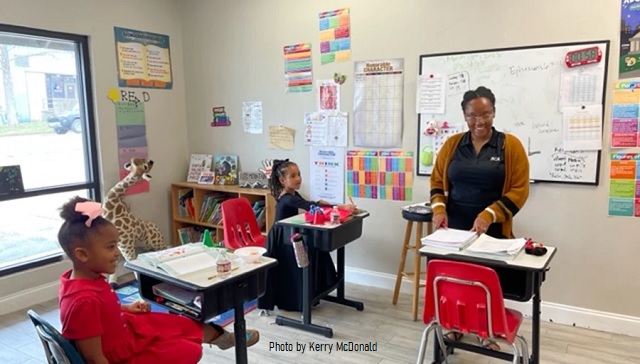Planned Parenthood’s Trans Hormone Business Is Booming, Creating Thousands Of New Patients ‘For Life’

The number of transgender services performed at Planned Parenthood clinics exploded over the past few years as the transgender medical industry became increasingly lucrative, according to data published by the organization’s regional branches.
Planned Parenthood first began providing hormone treatments for transgender patients in 2005, and since then 41 out of 49 regional branches have provided transgender services as of 2022. However, in just the last three years, Planned Parenthood has become dramatically more involved in the gender hormone industry.
Between 2020 and 2022, the number of transgender services performed and/or visits related to transgender treatments at Planned Parenthood clinics increased by roughly 125%, according to a Daily Caller News Foundation review of available data. Regional branches that made their data available collectively saw 17,036 visits in 2020 compared to 38,337 in 2022, a staggering increase in such a short period of time.
Michael Artigues, president of the American College of Pediatricians, told the DCNF that the increase seen over the last few years is likely due to a number of factors such as transgenderism becoming a growing “social phenomenon,” as well as potential financial incentives.
“You have to be concerned about the fact that there’s always money involved, for sure,” Artigues said. “And you’ve got to question whether or not they’re discerning if someone, in particular minors, have a legitimate condition that requires treatment like gender-affirming therapies, as opposed to a social phenomena and or simply mental health problems.”
While the national Planned Parenthood organization does not publicize data on visits related to transgender medical services, such as gender hormone therapy, 12 of the 41 regional Planned Parenthood branches have released relevant data over the past three years. The remaining branches did not respond to the DCNF’s requests for comment.
The regional offices varied in how they tracked gender services, with some tracking gender hormone therapy appointments and others tracking visits to their “gender-affirming care” programs; however, many of the regional Planned Parenthood organizations who published their data saw a substantial increase in visits and/or services performed for transgender individuals. Many clinics currently offer “Transgender Hormone Therapy” including estrogen, testosterone and puberty blockers.
Planned Parenthood Mar Monte, which has clinics located in California and parts of Nevada, had 1,041 “gender-affirming care visits” in 2020 before jumping to 4,378 visits in 2022 and eventually hitting 9,288 in 2023, according to its annual reports. The clinic offers hormone therapy for patients who are 18 years and older, or for patients 16 to 17 years old who obtain parental consent, according to its website.
Planned Parenthood Columbia Willamette, located in Oregon, recorded 344 transgender medical visits in 2018-2019 and 533 in 2019-2020. That number of visits went up to 1,066 in 2020-2021, and the following year it was nearly four times higher at 4,129 visits.
Nationwide, Planned Parenthood saw over 35,000 patients for hormone replacement services appointments in 2021, NPR reported. The organization did not disclose the exact number of gender-related visits in its 2022 annual report but instead listed them under “other procedures,” which totaled 256,550 appointments and included services like “pediatric care … other adult preventive care, and high complexity visits, including infertility services.”
NOTE: The graphic includes Planned Parenthood’s annual totals for “Gender Hormone Therapy,” “gender-affirming” or transgender visits and services at 12 affiliates with reports from 2020 to 2022. (Megan Brock/Kate Anderson)
Several branches said that their transgender services were some of the fastest-growing areas for their clinics. Planned Parenthood Illinois said in its 2022 report that its transgender hormone therapy is “growing faster than any other service.” The report also noted that “gender-affirming care requires a lifelong continuum of social, psychological, behavioral and medical care.”
Stella O’Malley, psychotherapist and executive director of Genspect, an international group that advocates for a “healthy approach to sex and gender,” told the DCNF that she believes Planned Parenthood has gone from the “medical model, where doctors are bound by the principle to ‘first, do no harm,’ to a more business-like approach that lets the buyer beware.”
“The problem with this is that very vulnerable people who are at their lowest often need guidance and support, not a business-like exchange,” O’Malley said. “Doctors aren’t shopkeepers. They are paid very well because they’re in positions of responsibility, and so they need to meet these responsibilities by being sensitive to the needs of the patient. A one-size-fits-all approach that fast-tracks most patients onto a medicalized pathway is profoundly inappropriate.”
Overall, the cross-sex surgery market is projected to be worth $5 billion in 2023, according to Grand View Research, thanks in large part to more and more Americans identifying as transgender. The cost of routine medical visits for a patient on gender hormones would also be significant.
Only a few of the affiliates reviewed by the DCNF list prices for their gender services; Planned Parenthood of the St. Louis Region and Southwest Missouri lists a “self-pay fee for a visit” at $250, with additional costs added for any lab work, according to its website. All follow-up visits are $200, plus costs to cover lab work as needed.
Planned Parenthood Pasadena & San Gabriel Valley estimates costs of up to $262 for the first visit, as well as $35 for hormone injection training and up to $48 for lab work, according to its website. Any follow-up visits can cost up to $202.
As of 2022, Planned Parenthood Metropolitan New Jersey said that its new patient consultation for transgender hormones ranged anywhere from $92 to $206, while follow-ups were slightly lower, going from $65 to $173, according to a welcome packet.
Scott Newgent, a detransitioner and founder of TReVoices, an organization that works to stop the medical transitioning of children, told the DCNF that the nature of gender hormone treatments, which must be taken continuously for the remainder of a patient’s life, creates potential repeat customers for organizations like Planned Parenthood.
“It doesn’t matter if they decide to transition or stay trans or whatever,” Newgent said. “They’re going to need those synthetic hormones for life. That’s a huge business model.”
Doctors have also raised concerns over the ease with which one can get a prescription for hormone treatments at Planned Parenthood; the Columbia Willamette affiliate, for instance, says on its website that it provides hormone treatments for patients 18 years and older and does not require a letter from a counselor or doctor recommending hormones for gender dysphoria. Patients can get a prescription after the initial hour-and-a-half appointment.
Erica Anderson, who is transgender and the former president of the U.S. Professional Association for Transgender Health, said that patients have circumvented more traditional methods of getting hormones because it takes too long, opting to go to Planned Parenthood instead, according to the Washington Free Beacon.
Click here to view Planned Parenthood Trangender Healthcare Services Infographic.
NOTE: The graphic includes Planned Parenthood’s totals for “Gender Hormone Therapy,” “gender-affirming” or transgender visits and services at 20 affiliates from 2020 to 2022. (Megan Brock/Kate Anderson)
The DCNF also reviewed an additional eight branches that released only partial data in their annual reports between 2020 and 2022. Planned Parenthood of the Pacific Southwest recorded only 22 “gender-affirming” hormone therapy telehealth visits in 2020 but did not include any data regarding in-person health care center visits for hormone therapy in its annual report.
In 2021, the branch saw 829 telehealth and health care center visits for gender hormones, and in 2022 had 2,426, according to its annual reports.
Planned Parenthood’s St. Louis Region and Southwest Missouri saw 238 visits between July 2020 and June 2021 as it rolled out its “transgender care program,” according to its annual report. Between July 2021 and June 2022, visits for hormone therapy jumped to 1,657.
Click here to view the Planned Parenthood Transgender Healthcare Services 2020 – 2022 Infographic
NOTE: The graphic includes Planned Parenthood’s totals for “Gender Hormone Therapy,” “gender-affirming” or transgender visits and services at 20 affiliates from 2020 to 2022. (Megan Brock/Kate Anderson)
Planned Parenthood California Central Coast reported 299 “gender-affirming care” initial and follow-up visits for the fiscal year 2019-2020 but logged 746 only two years later in its annual report for 2021-2022. Planned Parenthood Wisconsin in 2020-2021 had 488 hormone therapy visits, but that number jumped to 730 in 2021-2022.
Planned Parenthood Great Northwest reported only 659 “gender-affirming hormone care” visits in 2018 within the first six months of opening its gender program. However, in 2022, the number increased to a staggering 12,814 visits among 5,926 patients. While the Great Northwest branch absorbed the Indiana and Kentucky regions in 2021, those organizations did not list the number of transgender services they provided in their previous annual reports.
There are serious health risks from transgender hormone treatments; minors can become infertile if they receive puberty blockers, while those who transition later could suffer from other conditions such as bone deterioration after trying to come off testosterone.
“Women that get on testosterone for a long period, and then get off of it, their bones deteriorate,” Newgent said. “So I have to get back on testosterone to have my bones safe, but then I have to deal with the other sides of it. So there’s all these medical complications that come with it.”
Planned Parenthood published a series of videos in July acknowledging that patients who take estrogen hormones are at a higher risk of blood clots in the lungs, brain and legs.
Risks for testosterone therapy include blood clots, low blood sugar, high cholesterol and liver issues, according to the videos. Planned Parenthood also suggests that patients receiving hormone therapy should look into “family planning” options, noting that infertility is a potential side effect.
Planned Parenthood should “prioritize evidence-based medicine” and encourage patients, specifically children, to get “intensive psychiatric assessment and care” instead of offering puberty blockers, Dr. Stanley Goldfarb, chairman of Do No Harm, a group of medical professionals that oppose “radical” ideology in health care, said in a statement to the DCNF.
Planned Parenthood did not respond to the DCNF’s requests for comment.
AUTHORS
MEGAN BROCK AND KATE ANDERSON
Contributors.
RELATED ARTICLE: EXCLUSIVE: School Staff Appeared To Hide ‘Gender Identity’ Of Bullied Student Being Told To Commit Suicide
EDITORS NOTE: This Daily Caller column is republished with permission. ©All rights reserved.
All content created by the Daily Caller News Foundation, an independent and nonpartisan newswire service, is available without charge to any legitimate news publisher that can provide a large audience. All republished articles must include our logo, our reporter’s byline and their DCNF affiliation. For any questions about our guidelines or partnering with us, please contact licensing@dailycallernewsfoundation.org.




